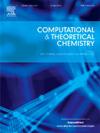Two bond-exchange modes in sodium silicate liquids: Slide and oscillation modes
IF 3
3区 化学
Q3 CHEMISTRY, PHYSICAL
引用次数: 0
Abstract
The network structure of polymerized silicate liquids suppresses the diffusion mechanism of silicon and oxygen atoms. Several diffusion model for these network forming elements have been presented based on nuclear magnetic resonance spectroscopy and molecular dynamics simulations. The authors' previous study introduced the concept of bond-breaking/forming particle, that can analyze quantitatively the certain bond exchange event from pair correlation functions of those particles. In this study, the angular part of the pair-correlation function of bond-breaking/forming particles was introduced, and an atomistic description of the two different bond exchange modes, that found in the author's previous study, was revealed. The first peak represent exchange of Si![]() O bonds in a sliding manner, whereas the second peak correspond to exchange in an oscillating manner. The inner product of vectors correspond to broken and newly formed bond is zero to positive in former mode, negative in latter mode.
O bonds in a sliding manner, whereas the second peak correspond to exchange in an oscillating manner. The inner product of vectors correspond to broken and newly formed bond is zero to positive in former mode, negative in latter mode.

硅酸钠液体中的两种键交换模式:滑动模式和振荡模式
聚合硅酸盐液体的网状结构抑制了硅原子和氧原子的扩散机制。基于核磁共振波谱和分子动力学模拟,提出了这些网络形成元素的几种扩散模型。作者在之前的研究中引入了断键/成键粒子的概念,可以从这些粒子的对相关函数中定量分析某些键交换事件。在本研究中,引入了断键/成键粒子对相关函数的角度部分,揭示了作者之前研究中发现的两种不同的键交换模式的原子性描述。第一个峰表示SiO键以滑动方式交换,而第二个峰对应于以振荡方式交换。断裂键和新生键对应的矢量内积在前一种模式下为0到正,在后一种模式下为负。
本文章由计算机程序翻译,如有差异,请以英文原文为准。
求助全文
约1分钟内获得全文
求助全文
来源期刊

Computational and Theoretical Chemistry
CHEMISTRY, PHYSICAL-
CiteScore
4.20
自引率
10.70%
发文量
331
审稿时长
31 days
期刊介绍:
Computational and Theoretical Chemistry publishes high quality, original reports of significance in computational and theoretical chemistry including those that deal with problems of structure, properties, energetics, weak interactions, reaction mechanisms, catalysis, and reaction rates involving atoms, molecules, clusters, surfaces, and bulk matter.
 求助内容:
求助内容: 应助结果提醒方式:
应助结果提醒方式:


